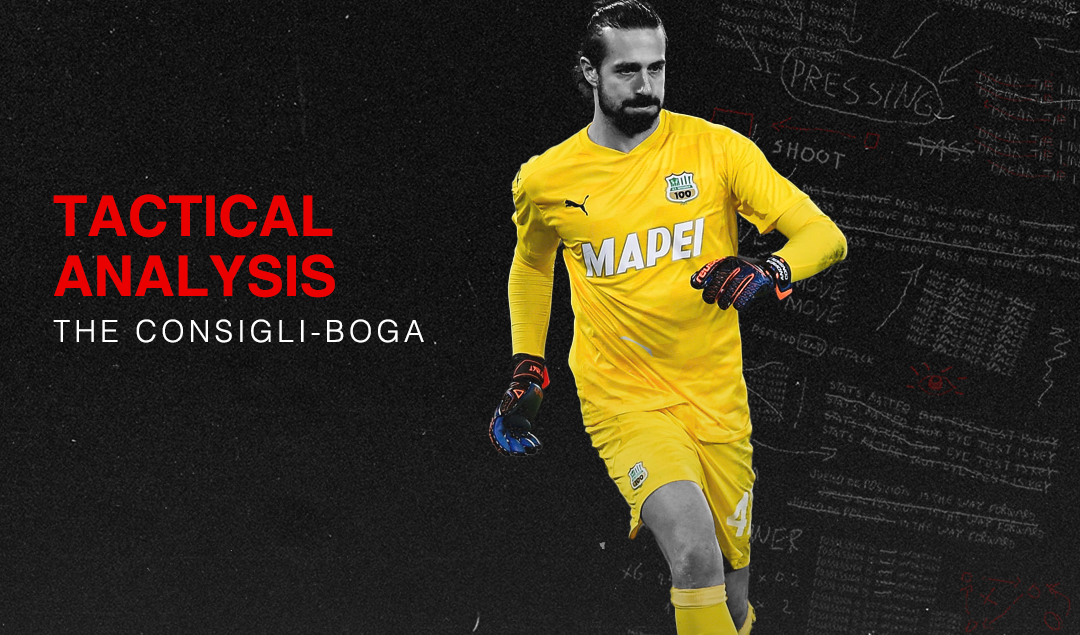The Consigli-Boga: Analysing Goalkeeper Possession against Mid-to-High Passive Blocks
Passivity as a concept can be applied microcosmically or macrocosmically. Since this article is referring to a very particular manoeuvre which can occur in games, the difference is in reference to a sequence, contrasted with holistically, and in fact, the approach discussed in this article often requires opposition cooperation through playing a higher line while not engaging meaning it is not a particularly effective tool against macrocosmically passive teams, or in layman’s terms, low blocks.
Therefore, the team must be microcosmically passive and macrocosmically closer to active defensively on the continuum (massive simplification) which manifests itself in a mid-to-high block seeking not to engage on the first line for this to work. Against higher pressing sides, backwards depth and goalkeeper involvement are still good strategies; however, different methods must be used. The mid-to-high passive block is therefore a necessary condition.
The starting theory underpinning the concept is the ability for the goalkeeper to act as a +1 in possession because they are often unaccounted for by marking schemes, particularly those more man-oriented. The additional player makes achieving numerical parity within whatever specified area more difficult, which is required to effectively press the opposition team under the schema of man-orientation.
This often leads to the goalkeeper achieving significant amounts of time and space in possession as there is no direct systematic response to their holding of possession as the defending team orients themselves around their respective opponent. This can allow for possession to become consolidated in higher areas as the goalkeeper can go for considerable periods within facing direct opposing pressure, amplifying the threat of the ball in behind.
Nonetheless, goalkeeper possession occurs in deeper areas with the advancement being from the typical active possession participation spot of in and around the box to the periphery of the first third. Furthermore, it occurs when the game state is consolidated which also potentially leads more zonal systems to prioritise preventing progression in between the lines through sitting off with regards to line of engagement to converge around the deeper actors through remaining compact to form pressing traps when the team in possession attempt to progress through shorter means.
Moreover, static game-states can be a trigger to adopt man-orientation because the discombobulating movement which positionally manipulates the man-oriented set-up is more difficult to achieve as capitalising upon the temporary gaps which appear consequently require more fluid movement in tighter spaces, although, as will be demonstrated, there is still potential for positional manipulation to create infiltratable space.
Additionally, these types of sequences frequently occur after the team in possession has played a backwards pass, often from more advanced regions which possibly worries the team out of possession as they are potentially being manipulated into losing vertical compactness through press-baiting which could lead them to conclude reconfiguring in their mid-to-high block is optimal to alleviate pressure previously being applied while maintaining structure, leading to the goalkeeper having possession relatively high whilst the opposition are simultaneously passive but also high – a recipe for potential infiltration in behind.
To analyse less abstractly, here is a tangible example in the grandest stage of them all – the Champions League final.
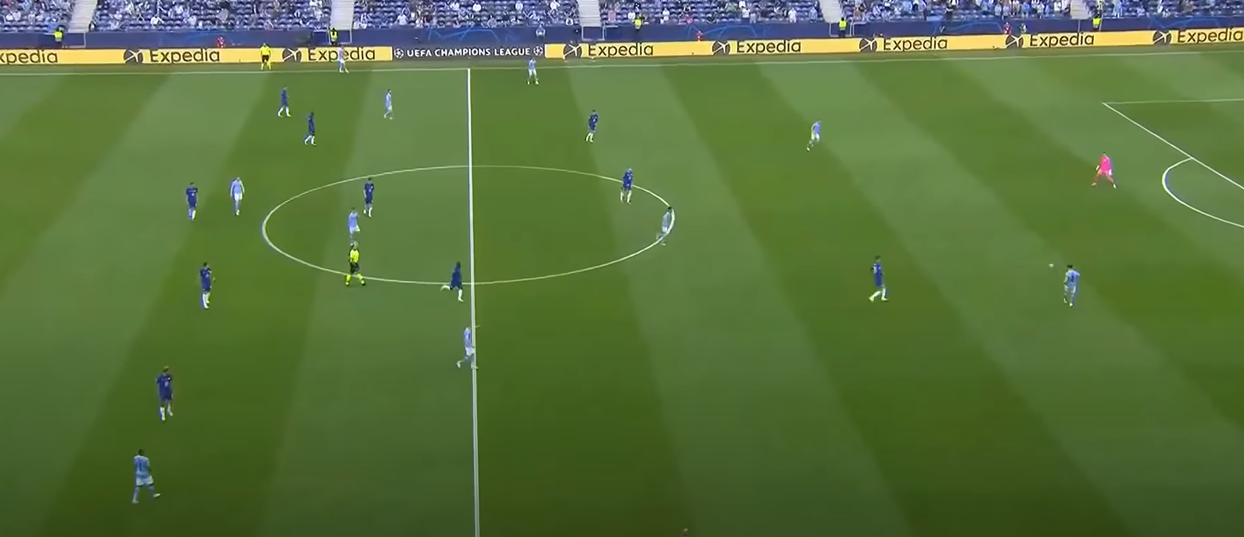
Ederson is positioned centrally which is pertinent because it gives him the greatest amount of accessible area, stretching Chelsea horizontally. Additionally, the positioning of Riyad Mahrez and Raheem Sterling is important to consider because are what make that space effective forcing Chelsea’s full pitch coverage. Having wingers vertically stretch on the last line while additionally providing almost maximum width is crucial because it creates gaps.
Vertically the forwards are tasked with dragging centre backs (this will be seen more with the 4-2-4 of Sassuolo) and horizontally to drag the wingback out wider to reduce the compactness between himself and the centre back therefore creating more space to invade. This provides the conditions to allow the manoeuvre to take place as Ederson has time and space in possession while Manchester City’s wingers pose a threat in behind.
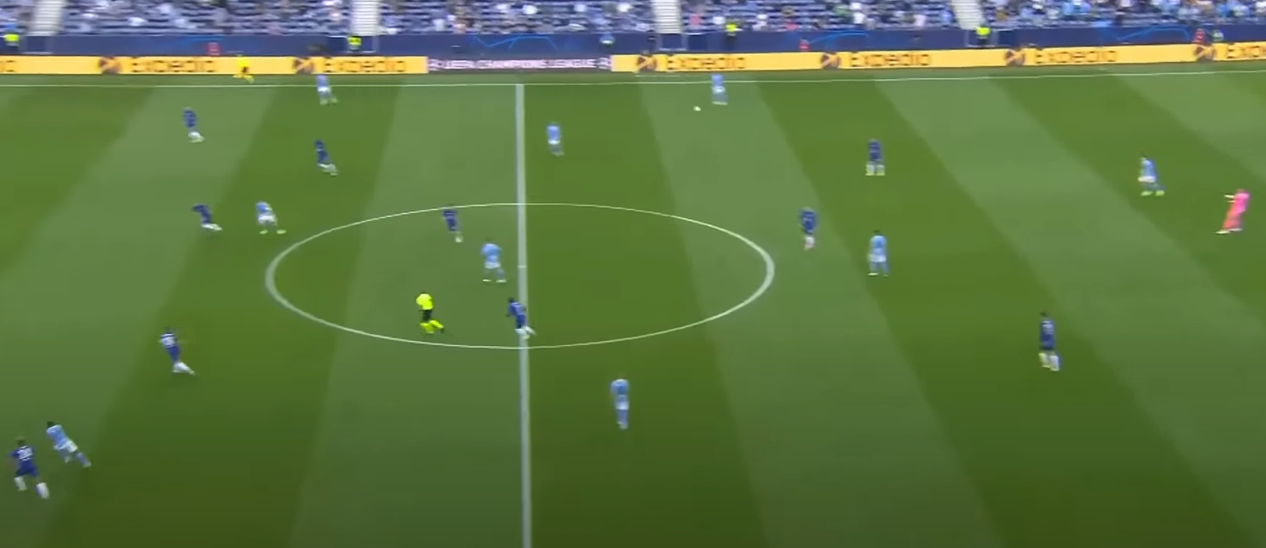
Another critical element is Sterling inverting with his movement which leads him to be goalside of his marker in Reece James which places him in a more dangerous position after ball reception, with the diagonality of the run into space meaning he has bypassed his marker without having to engage in a direct duel. This is why I think Pep Guardiola opted to play Sterling despite doubts over his form, because he is theoretically best suited to this type of movement which directly targets the exploitable space in a back three.
Notable in the way Chelsea play is the aggression of their wide centre backs to engage in duels and tightly mark limit the effective space the opponent has in between the lines. However, this leaves holes in behind. Thus, through positioning Sterling, accustomed to holding width, inverted, and renown for his fantastic off the ball movement on the flank, Pep had the perfect player to exploit this space.
This is but one manifestation of the potentiality, and the best example on the night as City did not use this strategy often, and they often lacked sufficient depth to vertically stretch Chelsea’s forward line to the extent where there would be too much space in between the lines should they seek to maintain an effective pressing distance on the centre backs.
Chelsea combated a similar direct ball maneuverer but from centre backs to Sterling as despite not pressing the CB’s, they were in close enough proximity to block and/or press when the centre back was setting up to go long. This is where the goalkeeper becomes important, as he is not covered by a player directly meaning there is no one within effective pressing distance to block any potential long passes, nor provoke inaccuracy via pressure.
Moreover, this is why I think the strategy is more effective against teams that defend in a back five because they are more susceptible to infiltration in the half-spaces direct from goalkeeper consolidated possession as they require more man-oriented centre back solutions to make up for lack of midfield coverage/space in between the lines compared to a back four which is more zonal typically and therefore the back 4 typically stay compact on the last line leading the exploitable space being in wide regions when the wingers are pushed wide.
The lack of wide coverage is the weakness in those examples whereas the wing-backs are wider comparatively reducing horizontal compactness when a centre back steps out, facilitating inwards wide movement where the attacker has the initiative because the move is likely pre-planned meaning they have more information about likely subsequent actions to work with in addition to man-oriented defensive strategies being intrinsically reactive which is what makes them so susceptible to rotations as the attacker has the initial invading momentum.
The ball over the top by Ederson and well-timed run by Sterling made the move almost indefensible which demonstrates the importance of the goalkeeper as an actor in possession because they are afforded the time and space for accuracy. César Azpilicueta is well-positioned to deal with the direct ball, having not been dragged out of position.
The importance in this example is the importance of the initiative in making a run, and time and space to make the pass successfully in addition to Ederson’s unparalleled (relative to other goalkeepers) technical proficiency with regards to playing long passes. In addition, despite the centre back postioning remaining largely lateral, I still don’t think this occurs against a back 4 configuration because the compactness between the centre back and full back prevents inwards invasion into the half-spaces of this manner.
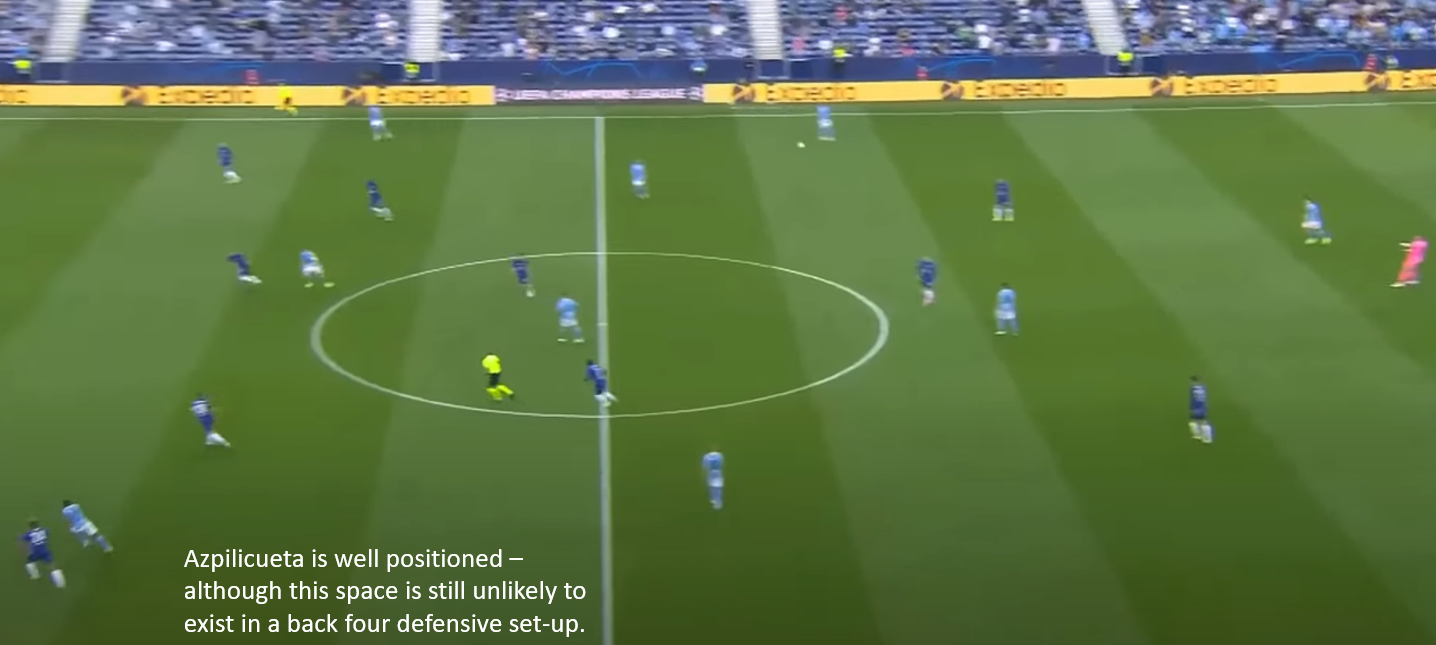
There are difficulties associated with ball reception and being under pressure from a tight marker. However, being able to quickly transition from goalkeeper possession to a possession such as this, which the still albeit makes look more dangerous than it is, is a useful asset to have in the arsenal of chance creation.
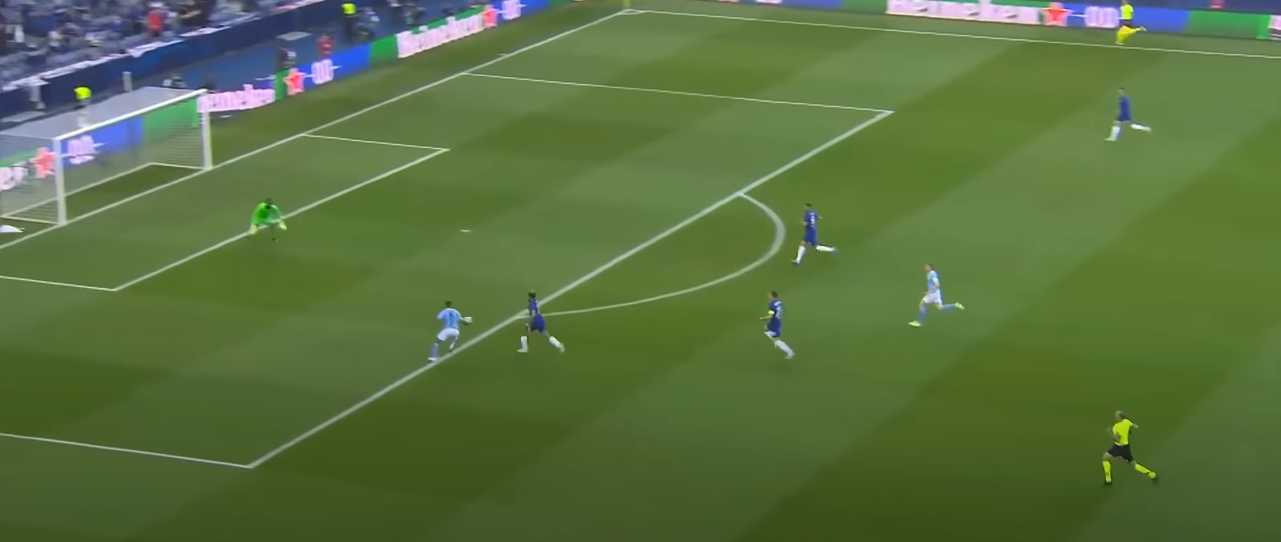
A potential counterargument suggests is only achievable with the previously mentioned unparalleled passing range of Ederson. Therefore, to rebuttal, I would like to show the example of Andrea Consigli and Jérémie Boga which my first and subsequently most common exposure to this of manoeuvre, which has led me to colloquially refer to it as “The Consigli-Boga”.
The best examples are typically against man-oriented Atalanta who simultaneously presses high with full vertical pitch coverage rather than other sides, where the man-orientation may be present, but engagements/marking occurs on the 2nd rather than first line.
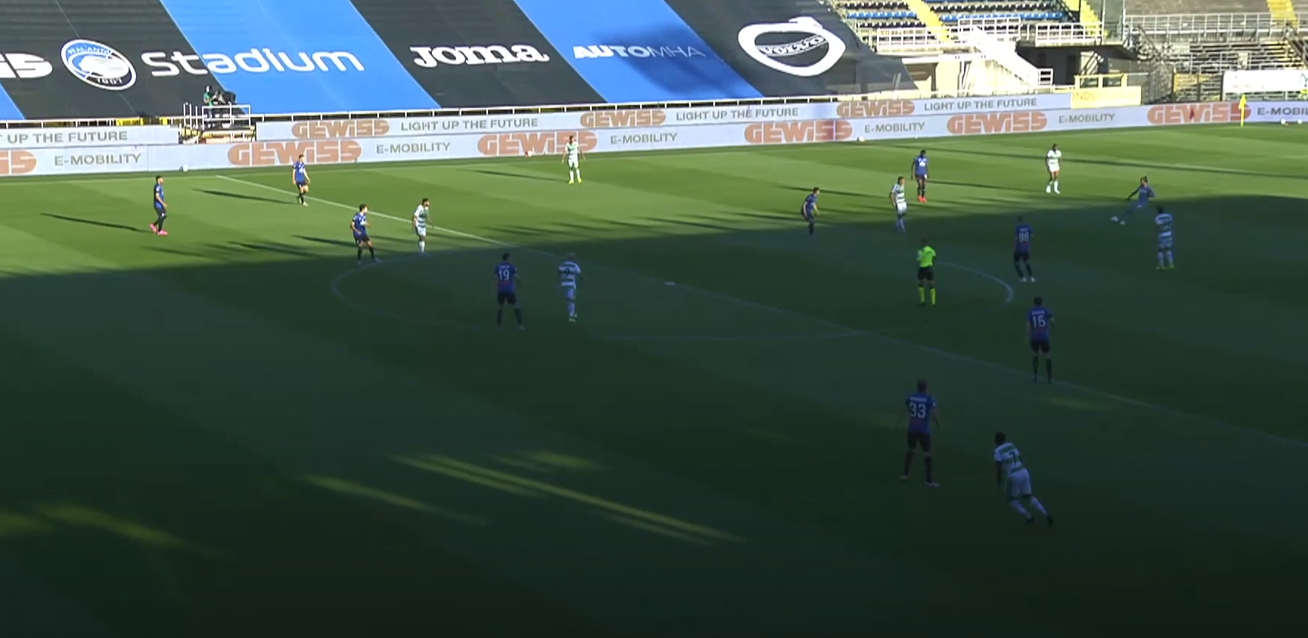
Boga makes an inverted movement in behind wing-back Hans Hateboer. Positional manipulation is more evident here from Sassuolo as Francesco Caputo and Grégoire Defrel are positioned asymmetrically to draw opposition commitment, extending the gap horizontally between Hateboer and Berat Djimsiti while Domenico Berardi is so wide as to be out of picture dragging the defensive shape over additionally as Atalanta’s left flank must initially orient themselves around him due to the pinning effect of high wide wingers through potentialities such as the one’s being discussed here.
This generates exploitable space for a similar goal side, tight marking interaction to occur as Sassuolo can quickly transition into a good opportunity through exploiting the potential for a goalkeeper having time in possession to prepare automatised moves which are difficult to execute accurately while under pressure.
It would be remiss not to discuss positive externalities of such positioning such as the (1)4-2-4 created by this manoeuvre such as the pinning effect of the wingers leading to the wingbacks and centre-backs in a man-oriented system being doubled generating time and space for the full backs in possession should they receive, which allows them to receive the ball with a forward body orientation.
They are then subsequently pressured by the wingbacks; however, the primary purpose of man-orientation, to make ball reception difficult through forcing backwards reception which has a compacting effect through limiting progressive options is undermined. This is highlighted here:
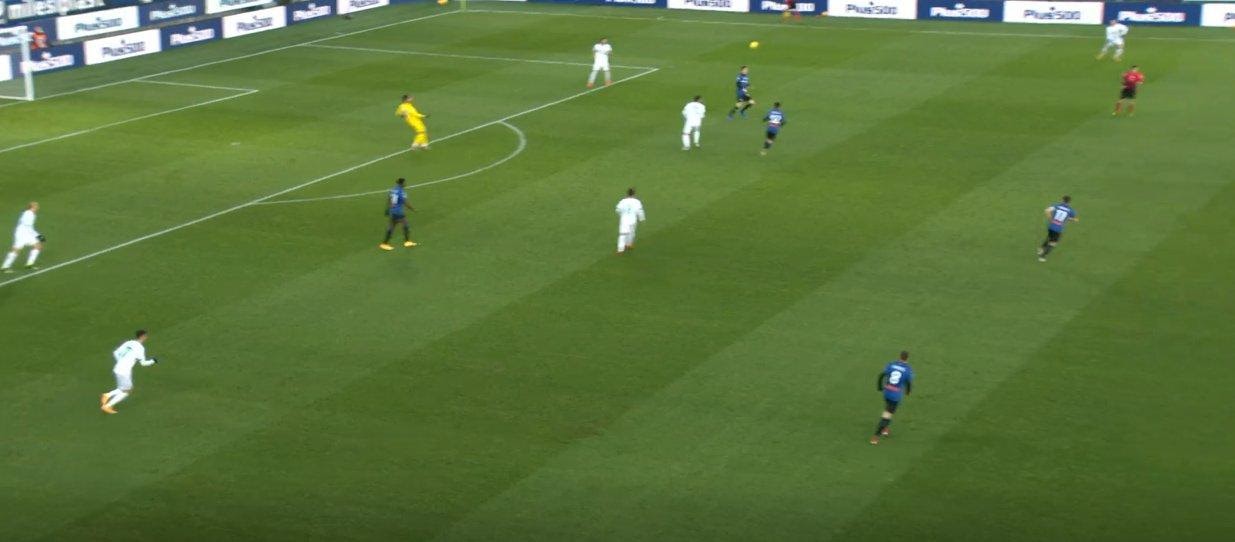
Consigli can distribute to wing-back freely because of the pinning effect of the winger. Because the ball reaches the Giorgos Kyriakopoulos quicker than the wingback can pressure, he can receive with forward body orientation, undermining the desired compacting effect of man-orientation.
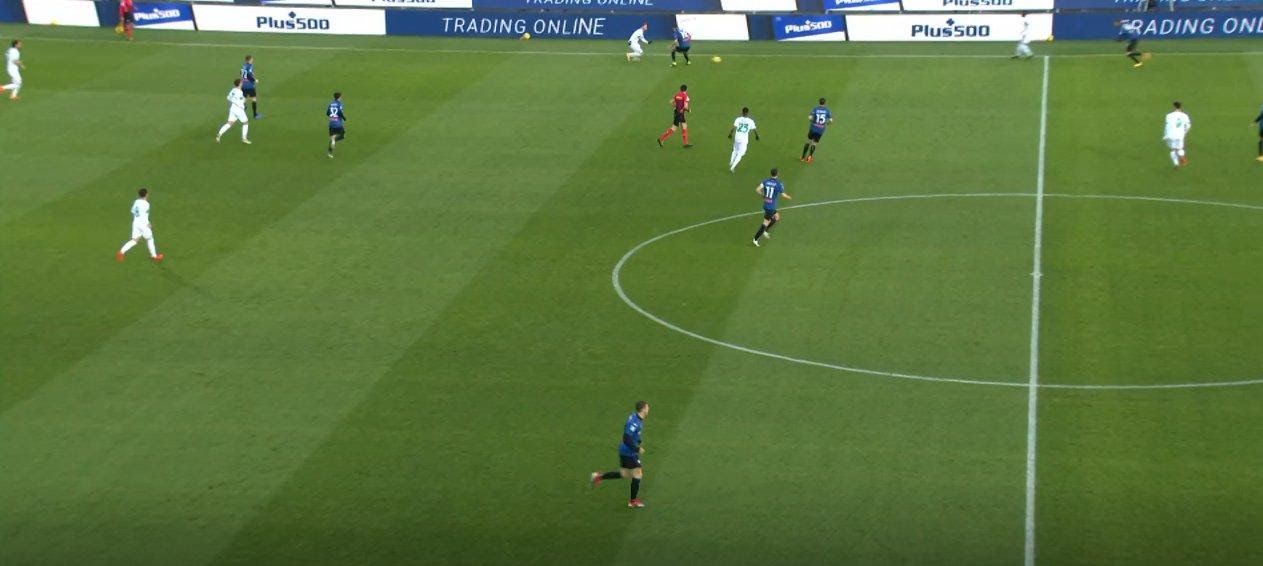
This allows for a give and go to be attempted where the compacting effect of man-orientation serves to benefit the possession side because the space in behind is now made effective as Sassuolo use the 1-2 to bypass the initial pressure while Kyriakopoulos henceforth is inverting in his movement to central areas granting him better passing access, and meaning he is less easily constrained.
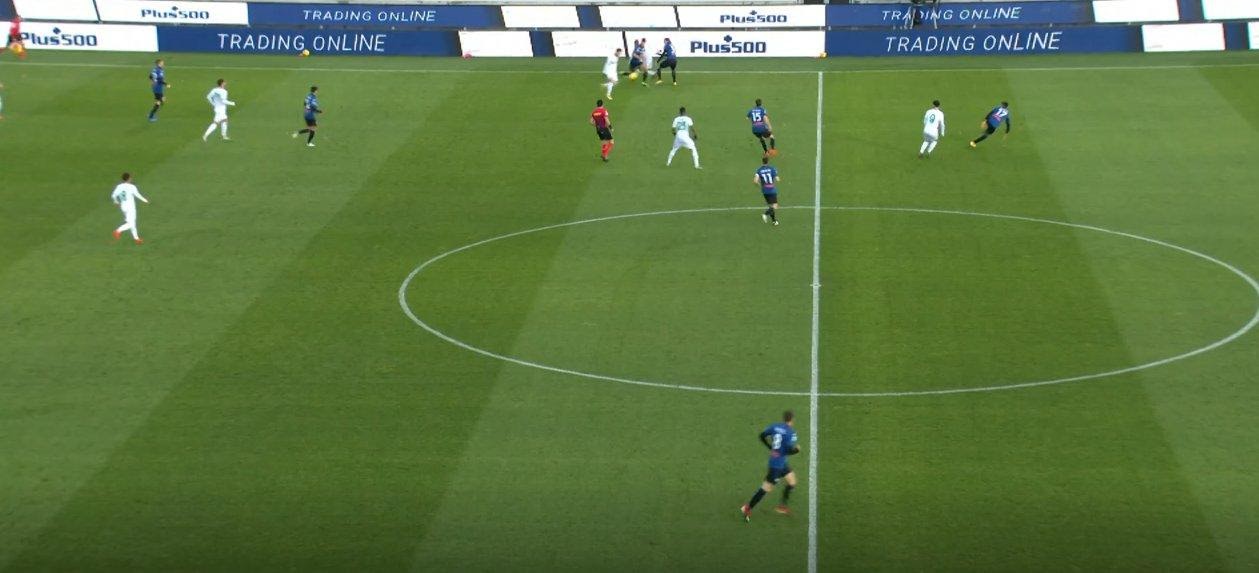
Other externalities can be facilitated in deeper regions due to deep-full back positioning which is somewhat outwith the intended remit of this article; however, to show quickly. Goalkeeper possession is central so facilities better connections out wide from the wide centre backs if the ball is circulated quickly as the wingback is pinned, meaning even more ground has to be made up to pressure.
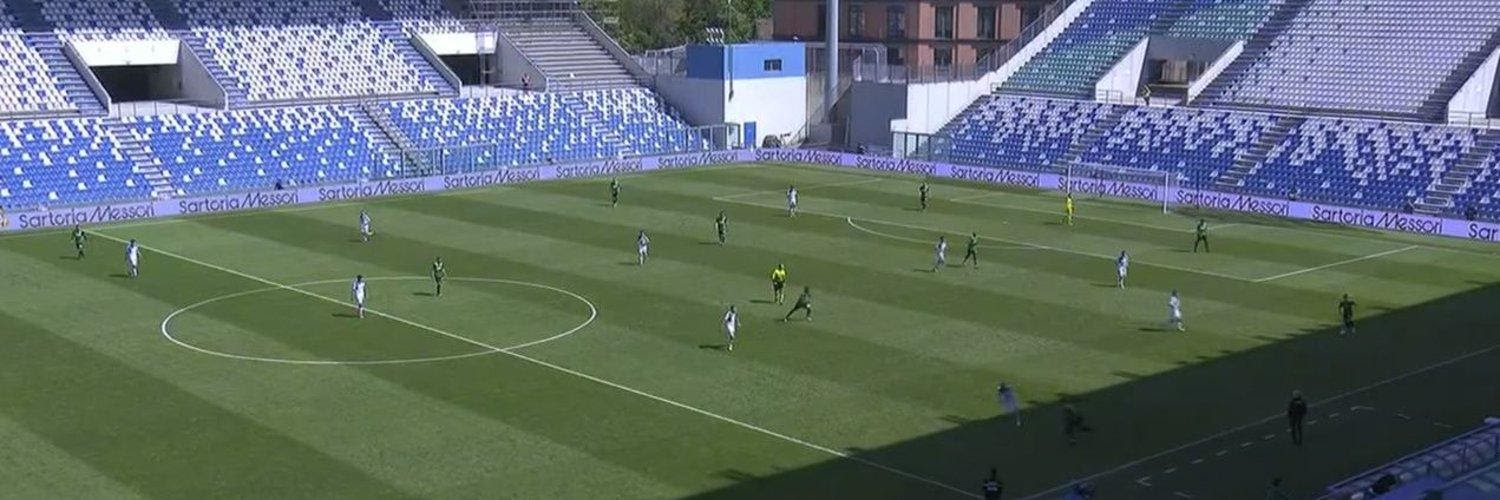
The full back receiving pressure acts a trigger for pressing higher down the flanks, meaning the wingback goes from doubling with the centre back to man-oriented around the fullback, forcing the wide centre back out wider, while here, Hamed Junior Traorè positionally manipulates through dropping deeper, creating the aforementioned exploitable space due to the man-oriented necessities of more active back 5’s.
Rogério is now better able to play a pass in behind, replicating the conditions mentioned from goalkeeper possession, which means these types of situations can be provoked in many ways. However, deep full backs and goalkeeper advanced possession are the best from which I am aware.
In conclusion, this article has demonstrated the utility from adding additional depth through goalkeeper involvement centrally when facing a mid-to-high block or man-oriented marking scheme (or a mix of both) in combination with tasking the wingers to be the primary vertical (as dropping forwards drag centre backs) and horizontal stretchers (to create the gaps through reducing horizontal compactness).
In doing so, they can generate exploitable space in the half-space for inverted reception which can quickly create 2v1 opportunities straight on goal in addition to the threat having other positive externalities such as additional time for full backs to receive possession, facilitating better wide link-up afterwards.
By: @mezzala8
Featured Image: @GabFoligno / NurPhoto
